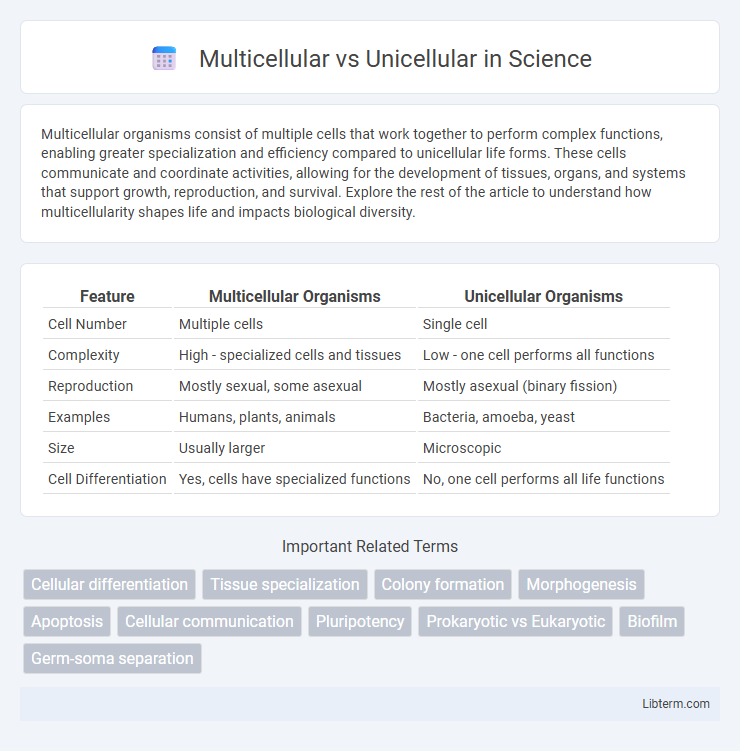Multicellular organisms consist of multiple cells that work together to perform complex functions, enabling greater specialization and efficiency compared to unicellular life forms. These cells communicate and coordinate activities, allowing for the development of tissues, organs, and systems that support growth, reproduction, and survival. Explore the rest of the article to understand how multicellularity shapes life and impacts biological diversity.
Table of Comparison
| Feature | Multicellular Organisms | Unicellular Organisms |
|---|---|---|
| Cell Number | Multiple cells | Single cell |
| Complexity | High - specialized cells and tissues | Low - one cell performs all functions |
| Reproduction | Mostly sexual, some asexual | Mostly asexual (binary fission) |
| Examples | Humans, plants, animals | Bacteria, amoeba, yeast |
| Size | Usually larger | Microscopic |
| Cell Differentiation | Yes, cells have specialized functions | No, one cell performs all life functions |
Introduction to Cellular Organization
Multicellular organisms consist of multiple, specialized cells that perform distinct functions, enabling complex biological processes and greater adaptability. Unicellular organisms, composed of a single cell, carry out all life functions independently within that one cell, often relying on simple structures like organelles for survival. Understanding cellular organization highlights the structural and functional differences essential for the diversity of life forms.
Defining Unicellular Organisms
Unicellular organisms consist of a single cell that performs all necessary life functions independently, including metabolism, reproduction, and response to stimuli. Common examples include bacteria, archaea, and many protists, which thrive in diverse environments ranging from extreme heat to aquatic habitats. Their simplicity contrasts with multicellular organisms, where specialized cells form tissues and organs for complex biological processes.
Key Characteristics of Multicellular Organisms
Multicellular organisms consist of multiple specialized cells that perform distinct functions, enabling complex structures and systems such as tissues, organs, and organ systems. These organisms exhibit cellular differentiation and interdependence, which enhances their ability to adapt, grow, and repair damaged tissues. Multicellularity allows for greater organismal size and complexity compared to unicellular counterparts, supporting more advanced biological processes.
Evolutionary Pathways: Unicellular to Multicellular
The evolutionary transition from unicellular to multicellular organisms involved the aggregation and specialization of individual cells, leading to enhanced survival and adaptation. Key genetic innovations such as cell adhesion, communication, and differentiation genes facilitated this transition, enabling complex body plans and tissue development. Fossil records and molecular studies demonstrate multiple independent origins of multicellularity across various lineages, including animals, plants, and fungi.
Structural Differences Between Unicellular and Multicellular Life
Unicellular organisms consist of a single cell that performs all necessary life functions independently, often exhibiting simpler structures such as a single nucleus, cytoplasm, and cell membrane. Multicellular organisms display complex structural differentiation, with specialized cells organized into tissues, organs, and systems, enabling division of labor for enhanced functionality and survival. Cellular communication and adhesion mechanisms in multicellular life facilitate coordinated activities, contrasting with the autonomous nature of unicellular organisms.
Reproduction Strategies in Unicellular vs Multicellular Organisms
Unicellular organisms primarily reproduce asexually through binary fission, budding, or spore formation, enabling rapid population growth and genetic consistency. Multicellular organisms utilize both asexual and sexual reproduction, with complex processes involving gamete production, fertilization, and development, promoting genetic diversity and adaptation. These distinct reproductive strategies reflect evolutionary adaptations to organism complexity and environmental stability.
Genetic Complexity and Diversity
Multicellular organisms exhibit greater genetic complexity due to specialized cells and intricate gene regulation networks, enabling diverse functions and tissue differentiation. Unicellular organisms maintain simpler genomes optimized for rapid replication and adaptation to environmental changes, resulting in genetic diversity primarily via horizontal gene transfer and mutation. The genetic diversity in multicellular species arises from sexual reproduction and cellular specialization, driving evolutionary innovation and complex organismal structures.
Adaptability to Environmental Changes
Multicellular organisms exhibit greater adaptability to environmental changes due to their specialized cells and complex systems that allow differentiation and coordinated responses to stress factors. In contrast, unicellular organisms rely on rapid genetic mutations and metabolic flexibility to survive fluctuating conditions, often thriving in extreme environments. The multicellular structure enables organisms to compartmentalize functions, which enhances resilience and long-term survival in diverse habitats.
Examples of Unicellular and Multicellular Organisms
Examples of unicellular organisms include bacteria such as Escherichia coli, protists like Amoeba, and yeasts such as Saccharomyces cerevisiae, all consisting of a single cell performing all life processes. Multicellular organisms include plants like oak trees (Quercus species), animals such as humans (Homo sapiens), and fungi including mushrooms (Agaricus bisporus), where specialized cells form tissues and organs to carry out complex functions. These examples highlight the diversity and complexity differences between unicellular and multicellular life forms across biological kingdoms.
Importance and Impact in Ecosystems
Multicellular organisms contribute to ecosystem complexity by forming diverse habitats and enabling specialized functions such as nutrient cycling and energy flow. Unicellular organisms play a crucial role in ecosystems through rapid reproduction and essential processes like decomposition and primary production, supporting food webs and nutrient availability. Both multicellular and unicellular life forms maintain ecological balance and drive evolutionary adaptation, highlighting their indispensable impact on ecosystem stability and resilience.
Multicellular Infographic

 libterm.com
libterm.com